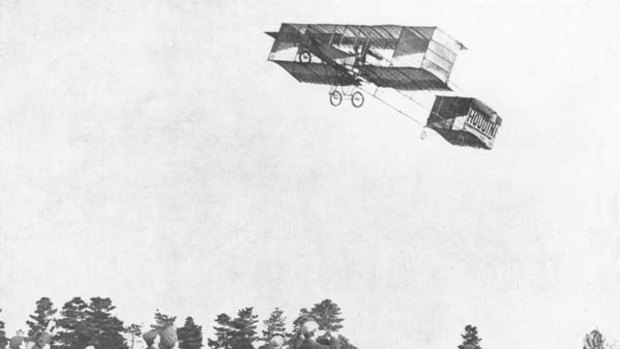By Andrew Heasley

Harry Houdini takes to the air in 1910.
From a box-kite bi-plane to the massive Airbus A380 superjumbo, Australian aviation has come a long way in a century.
It was 100 years ago today that Australia aviation was born.
Magician and escapologist Harry Houdini took to the skies over Diggers Rest in Victoria in Australia's first controlled flight in a powered heavier-than-air craft, a milestone that now marks a century of Australian aviation.
At dawn on March 18, 1910, Houdini soared into the sky and the history books with a feat that other pioneering aviators had tried but failed to accomplish.
His flight will be celebrated with a community festival and flying displays across Diggers Rest and Melton from today through to Sunday , along with with static displays of his rivals' endeavours at Museum Victoria's Scienceworks.
Houdini, who had learnt to fly in Berlin, was at the controls of his own Voisin box-kite bi-plane, imported from France.
In bare paddocks lined by tall trees at Plumpton Dam, Diggers Rest, clad in flying leathers and goggles, the daredevil, with the assistance of his French mechanic, Brassac, cranked the propeller and engine into life, its benzine igniting the hope of a new era of aviation.
With that, he climbed aboard, throttled the engine, and the craft rolled across the paddock, picked up speed to 40mph and ultimately broke free of gravity's clutch, clearing the ground.
He ascended to 100 feet, circled over a three kilometre arc and landed safely a minute later.
"There was a lot of competition to be the first, it was seen as big achievement to be the first flyer," says David Crotty, Museum Victoria's curator of engineering and transport exhibits.
Houdini's flight was the culmination of an aeronautical competition spruiked by rival travelling roadshow entrepreneurs of the day.
Englishman Colin Defries in a Wright brothers Type-A biplane failed in December 1909 to fly in a controlled manner, and crashed on his subsequent attempts.
That plane was sent to Diggers Rest to compete with Houdini, this time with American Ralph Banks as pilot, but crashed on March 1, 1910.
The day before Houdini's flight, on March 17 in Bilovar, about 30 kilometres north of Adelaide in South Australia, a group of three Australians led by Fred Custance claimed to have flown a Bleriot monoplane for five minutes and 25 seconds before dawn, but a lack of reliable witnesses and a crash on a second flight saw the claims discounted.
Watching Houdini's feat on March 18 at Diggers Rest were nine people, including Banks, who signed a document as to what they witnessed, earning Houdini a trophy from the Aerial League judges inscribed the "First Aerial Flight in Australia". It was the first of three flights Houdini made at Diggers Rest.
After Houdini, it wasn't until July 16, 1910, that Melbourne pilot John Duigan managed the first flight in his eponymous and hand-built biplane, at Mia Mia in Victoria, a replica of which is on display at Scienceworks.
Houdini's flight came four months after George Taylor launched his bi-wing glider off the dunes of Narrabeen and soared 100 feet and is considered Australia's first controlled flight by an unpowered craft.
LINKS
For community festival details, including aviation displays, go to: www.melton.vic.gov.au/houdini
Display of Defries' equipment and accomplishments, go to museumvictoria.com.au/scienceworks
Sign up for the Traveller newsletter
The latest travel news, tips and inspiration delivered to your inbox. Sign up now.